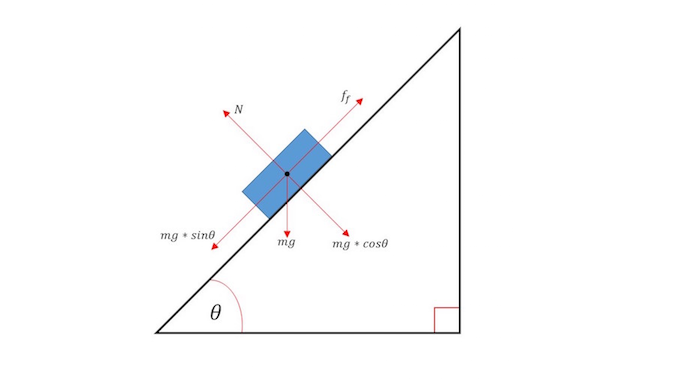Inclined Plane: Difference between revisions
No edit summary |
|||
| Line 29: | Line 29: | ||
===A Computational Model=== | ===A Computational Model=== | ||
Using GlowScript we are able to model a block on an inclined plane moving downward as it is being affected by gravity. | Using GlowScript we are able to model a block on an inclined plane moving downward as it is being affected by gravity. | ||
==Examples== | |||
==Technical Usage== | ==Technical Usage== | ||
Revision as of 12:43, 29 March 2017
Claimed by Catherine Grey Spring 2017
The Main Idea
We typically know an inclined plane as a flat surface that is higher on one end aka a big triangle. Inclined planes are commonly used to move objects to a higher or lower place. These slopes help to lessen the force needed to move an object but do require the object to move a greater distance, the hypotenuse of the triangular plane. Some examples of inclined planes include ramps, stairs, wedges (such as a door stopper), or even mountains which people sled down.
A Mathematical Model
This figure illustrates most of the forces that could act on an inclined plane. Depending on the question not all will be present, specifically friction.

Variables:
θ = Angle of the plane to the horizontal
g = Acceleration due to gravity
m = Mass of object
N = Normal force (perpendicular to the plane)
Ff = frictional force of the inclined plane (sometimes it is omitted on test problems)
mgSinθ = A force parallel to the plane (mgSinθ > Ff the body slides down the plane)
mgCosθ = A force acting into the plane (opposite to N)
Fnetparallel = The net parallel force acting on the object
Fnetperpendicular = The net perpendicular force acting on the object
Equations:
- [math]\displaystyle{ \ F_{net} = F_{net//} + F_{netperp} }[/math]
- [math]\displaystyle{ \ F_{net//} = F_f - mgSinθ }[/math]
- [math]\displaystyle{ \ F_{netperp} = N -mgCosθ }[/math]
A Computational Model
Using GlowScript we are able to model a block on an inclined plane moving downward as it is being affected by gravity.
Examples
Technical Usage
Terminology
Let's imagine there is a right triangle. The side opposite to the right angle is a Slant. The side on the bottom is Run The side vertical to the bottom is Rise
Slope: A slope brings a mechanical advantage to the incline plane.
- [math]\displaystyle{ \theta = \tan^{-1} \bigg( \frac {\text{Rise}}{\text{Run}} \bigg) \, }[/math]
Mechanical Advantage
Fw is a gravitational force that applies on the plane
Fi is a force exerted on the object and parallel to the plane
- [math]\displaystyle{ \mathrm{MA} = \frac{F_w}{F_i}. \, }[/math]
if the inclined plane is frictionless,
- [math]\displaystyle{ \text{MA} = \frac{F_w}{F_i} = \frac {1}{\sin \theta} \, }[/math] (in this case, [math]\displaystyle{ \sin \theta = \frac {\text{Rise}}{\text{Length}} \, }[/math])
if the inclined plane has a friction
- [math]\displaystyle{ \mathrm{MA} = \frac {F_w}{F_i} = \frac {\cos \phi} { \sin (\theta - \phi ) } \, }[/math] (in this case, [math]\displaystyle{ \phi = \tan^{-1} \mu \, }[/math])
- [math]\displaystyle{ \theta \lt \phi\, }[/math]: Downhill applied force is needed.
- [math]\displaystyle{ \theta = \phi\, }[/math]: Infinite mechanical advantage.
- [math]\displaystyle{ \theta \gt \phi\, }[/math]: The mechanical advantage is positive. Uphill force is needed.
History
An inclined plane is one of the six classical simplified machines defined by Renaissance scientists. They have been used for thousands of years to move large objects to a specific distance, such as with the potential creation Stonehenge or the formation of the Egyptian Pyramids. Since then inclined planes have become more complex and efficient allowing for us to more easily transport objects.
Connectedness
See Also
Free Body Diagram
Normal Force
References
Cole, Matthew (2008). Explore science, 2nd Ed. Pearson Education. https://books.google.com/books?id=RhuciGEQ1G8C&pg=PA178#v=onepage&q&f=false
http://hyperphysics.phy-astr.gsu.edu/hbase/Mechanics/incline.html